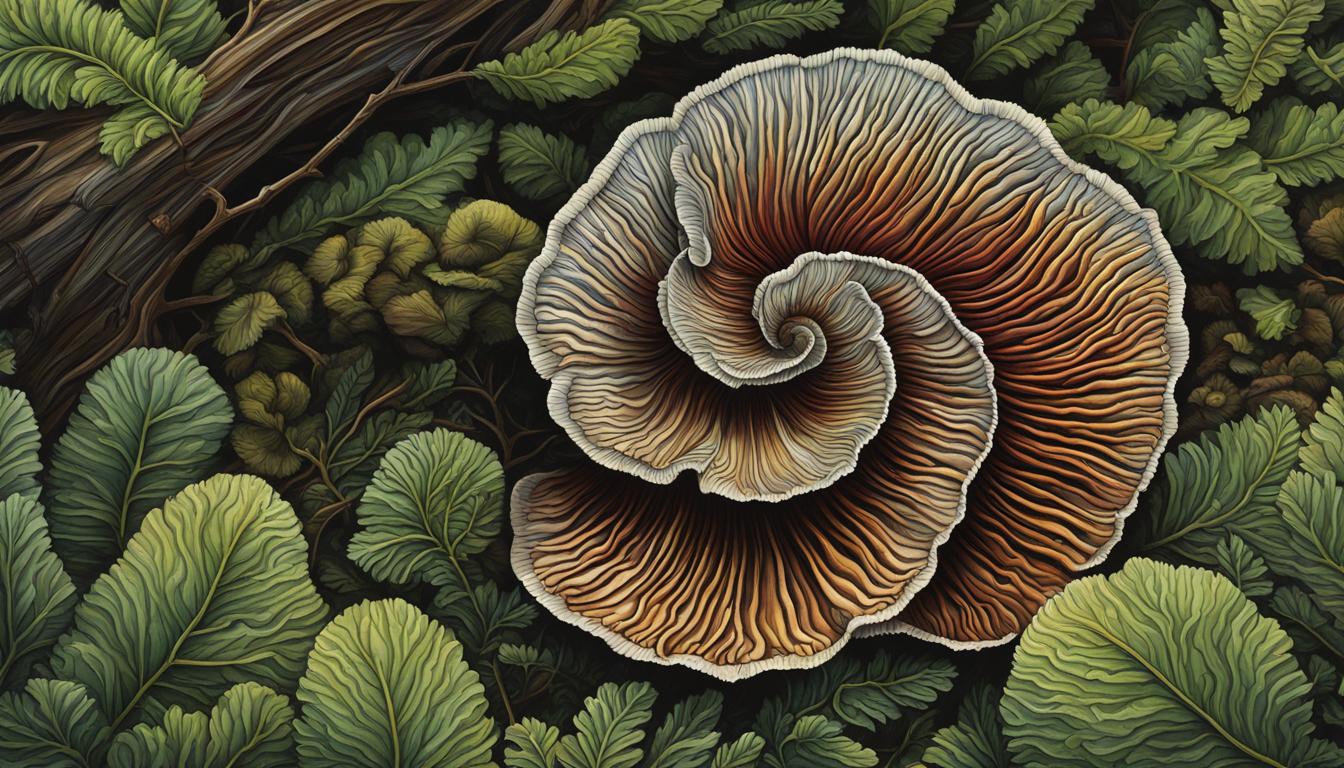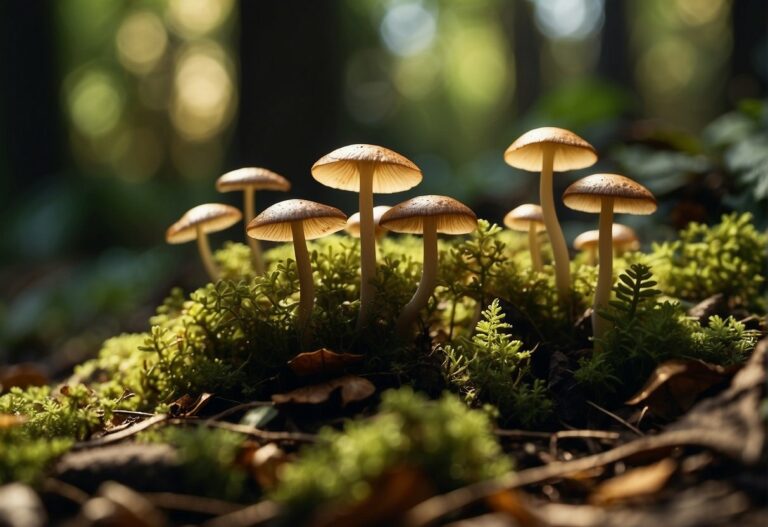As someone constantly on the quest for the next breakthrough in natural skincare, I’ve discovered an ingredient that stands out from the rest: the turkey tail mushroom. Scientifically known as Trametes versicolor, this mushroom is celebrated for its potential to revolutionize turkey tail mushroom skincare. My exploration into the world of fungi has led me to understand that the turkey tail mushroom benefits for skin are not just folklore; they are backed by an ever-growing body of scientific research.
Rich with bioactive compounds such as polysaccharopeptides (PSP) and polysaccharide-K (PSK), turkey tail mushrooms present a compelling case for those aiming for a youthful glow and healthier skin presence. The promise they hold in preventing damage, bolstering skin elasticity, and more is why I believe these mushrooms deserve a spotlight in the natural skincare narrative. Join me as we delve into the fascinating world of turkey tail mushroom skincare, unlocking the secrets nature has tucked away in these colorful, beneficial fungi.
Discovering the Power of Turkey Tail Mushroom for Skin Health
Table of Contents
Embarking on a journey to enhance skin health with natural remedies, Trametes versicolor or more commonly known as the turkey tail mushroom, has emerged to be a flagship among the skin-enhancing mushrooms. This illustrious fungus is not just a recent addition to unique skincare ingredients; it carries a legacy of therapeutic use, especially within Asian traditions.
An Introduction to Turkey Tail Mushroom
Characterized by its vibrant, concentric fan-shaped rings, the turkey tail mushroom is a captivating sight. Resembling the plume of its namesake bird, it’s a beauty in its own right, yet its allure goes beyond the superficial. It’s the mushroom’s bioactive components that draw my particular interest. These substances have garnered the attention of researchers and skincare aficionados for their potential to impart significant benefits for skin health.
Why Turkey Tail Mushroom Stands Out for Skincare
With the natural skincare industry constantly on the hunt for groundbreaking ingredients, turkey tail mushroom skincare solutions are carving out a name for themselves. What precisely puts the turkey tail mushroom in the limelight? Its abundance of PSP (polysaccharopeptides) and PSK (polysaccharide-K) positions it as a unique addition to the skincare regime, specifically formulated for those pursuing a revitalized and resilient complexion.
| Bioactive Component | Benefit |
|---|---|
| Polysaccharopeptides (PSP) | Believed to enhance skin regeneration and reduce inflammation |
| Polysaccharide-K (PSK) | Contributes to skin’s defense system and promotes overall resilience |
| Antioxidants | Combats oxidative stress, potentially slowing the aging process |
| Beta-Glucans | Aids in moisture retention and may improve skin elasticity |
These compounds, particularly PSP and PSK, are renowned for their potential to nourish and fortify the skin, making turkey tail mushroom a prominent candidate among unique skincare ingredients. It’s not merely about enhancing beauty superficially; it’s about nurturing the skin’s own strength and vitality from within. This is why turkey tail mushrooms might just be the frontrunner for those yearning to embrace the full spectrum of nature’s bounty for skin health.
From its awe-inspiring appearance that mimics the enigma of the natural world to its treasure trove of bioactive components, turkey tail mushroom for skin health isn’t just a trend — it’s a testament to the symbiotic relationship between nature and well-being. Join me as I continue to delve deeper, exploring the constituents that render this mushroom a superfood for the skin.
The Compounds Behind Turkey Tail Mushroom Skin Benefits
My in-depth exploration of the turkey tail mushroom skin benefits unearthed a trio of remarkable compounds that are the true stars behind its skin-enhancing prowess: PSP, PSK, and beta-glucans. The scientific community has shown a growing interest in these medicinal compounds, attributing to them a wealth of health benefits that extend to the realm of skincare.
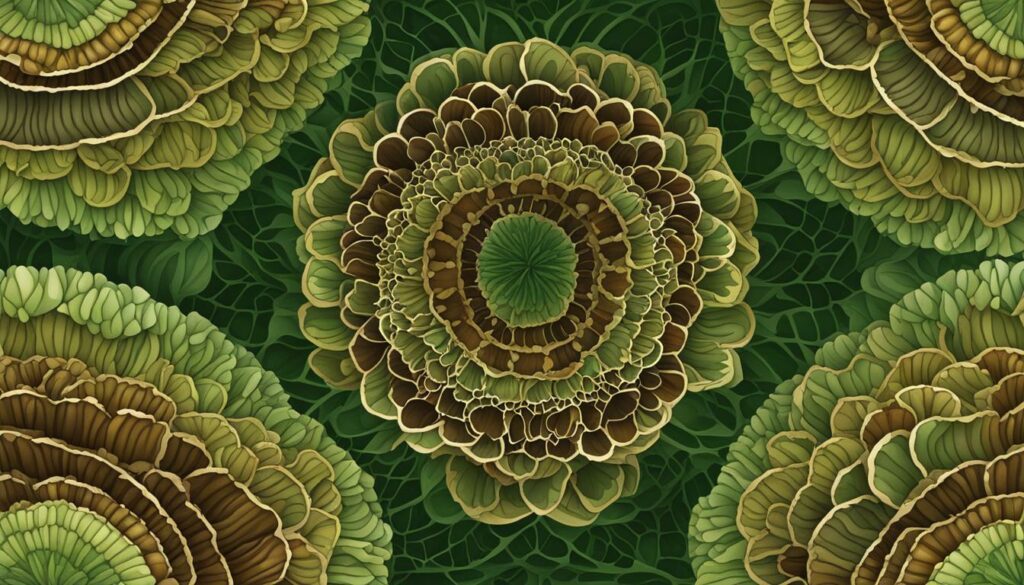
Polysaccharopeptides (PSP) and Polysaccharide-K (PSK) have been identified as the primary agents delivering the turkey tail mushroom’s skin benefits. PSP is known for its potential to spur skin regeneration and decrease inflammation, while PSK is celebrated for its capability to boost the skin’s defense mechanisms, contributing to its resilience and health.
To quantify the positive impact of these compounds on skin health, let’s refer to the following table, which includes the promising effects attributed to each component:
| Compound | Beneficial Effects for Skin |
|---|---|
| Polysaccharopeptides (PSP) | May encourage skin cell regeneration and have anti-inflammatory properties |
| Polysaccharide-K (PSK) | Known for fortifying skin’s defense against external stressors |
| Beta-Glucans | Could aid in moisture maintenance and bolster skin barrier function |
Moving beyond these primary compounds, the beta-glucans in turkey tail mushrooms deserve a special mention for their immune-modulating qualities. By potentially combating pathogens and diminishing inflammation, beta-glucans may offer an additional layer of support in maintaining skin health and integrity.
It’s not merely about addressing skin issues once they’ve arisen; it’s about fortifying the skin from within, offering it the tools to protect against and heal from day-to-day challenges.
In summary, these medicinal compounds present in the turkey tail mushroom work synergistically to promote a complexion that not only appears healthier but truly embodies resilience and vitality at a cellular level.
Antioxidant Properties of Turkey Tail Mushroom and Skin Rejuvenation
When it comes to maintaining a perpetual youthfulness and vitality in our skin, we often overlook nature’s own provisions—specifically, the turkey tail mushroom glow is thanks to its packed antioxidant arsenal. Delving into the heart of skin rejuvenation, I’ve discovered that the turkey tail mushroom is not just a health supplement; it’s a warrior in the battle for youthful skin.
Fighting Free Radicals for Youthful Skin
Our skin is under constant assault by free radicals, rogue agents that accelerate aging and degrade skin quality. Turkey tail mushroom, with its high antioxidant content, is like a shield against these invisible attackers. The ability of this mushroom to aid in fighting free radicals is not just a claim; it’s a scientifically observed marvel that may lead to significantly more youthful skin.
By integrating turkey tail mushroom into my skincare routine, I’ve seen the promise of this natural remedy reflected in the mirror with fewer signs of aging and more vibrant-looking skin.
Enhancing Skin’s Natural Glow with Antioxidants
There is an undeniable link between the antioxidants in skincare and the luminosity of the skin. In my journey through the world of holistic skincare, I’ve found that the turkey tail mushroom is an extraordinary source of substances that aid in enhancing skin glow. It’s these very antioxidants that help to impart a vibrant, natural radiance, suggesting an evolving role for turkey tail mushroom in rejuvenating skincare formulations.
The table below summarizes the antioxidant compounds found in turkey tail mushrooms and their noted benefits for skin health:
| Antioxidant Compound | Noted Skin Benefit |
|---|---|
| Quercetin | Assists in reducing inflammation and preventing oxidative damage |
| Baicalein | Has potential to protect against free radicals and mitigate UV impact on skin |
| Catechins | Known to enhance skin rejuvenation and improve elasticity |
| Vitamin E | Contributes to skin healing and may provide a moisture barrier |
My personal experience validates that regular incorporation of this mushroom into my skincare routine has not only reduced the signs of environmental stress on my skin but also allowed me to enjoy a more youthful and refreshed appearance. It’s a testament to the power of the turkey tail mushroom and its role in skin rejuvenation.
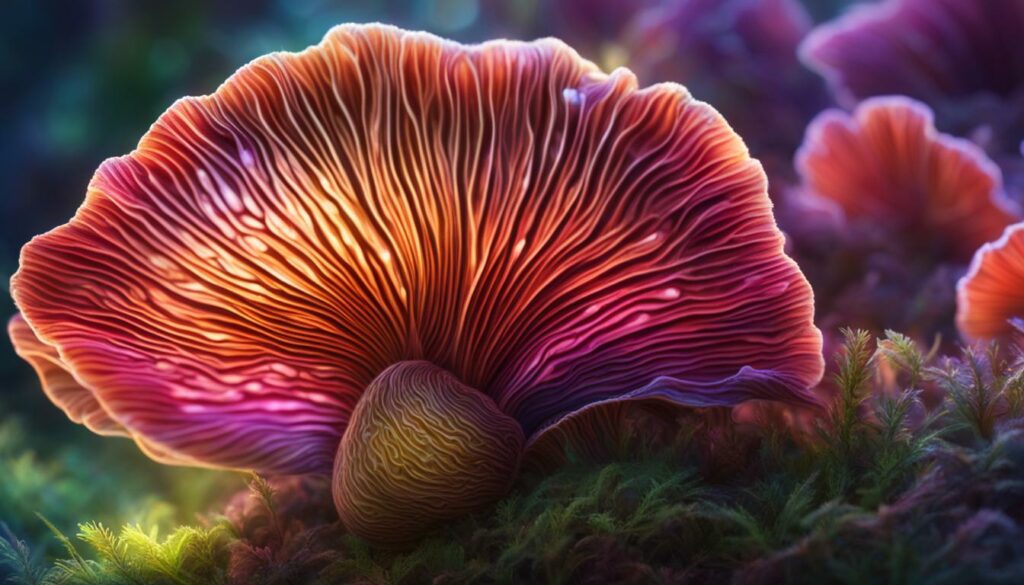
- Neutralizes skin-damaging free radicals
- Reduces signs of aging for a more youthful complexion
- Boosts overall skin health and luminosity
- Renders a protective effect against environmental stressors
It is with a newfound respect for the turkey tail mushroom that I continue to harness its potential, not only to stave off the visual implications of age but to nourish the skin with nature’s best defense against the march of time. The lessons from the turkey tail mushroom in skin rejuvenation are simple yet profound: incorporate its vast spectrum of antioxidants, and one may see the dawn of radiant, youthful skin.
Nutrient Profile: Turkey Tail Mushroom for Glowing Skin
The pursuit of a radiant complexion has led me to embrace the turkey tail mushroom for glowing skin, famed not only for its medicinal benefits but also for its rich nutrient profile. These mushrooms are a treasure trove of skin-boosting nutrients, establishing themselves as a vital source of nourishment for those seeking a natural path to beauty.
It’s the intrinsic combination of vitamins, minerals, and bioactive compounds within the turkey tail mushroom that underpins its ability to enhance dermal health. To illustrate the skin enriching properties of this remarkable fungus, let’s consider the detailed composition of its nutrient profile.
| Nutrient | Benefit for Skin Health |
|---|---|
| Vitamins (B-Complex, D) | Play a role in cell regeneration and repair damage |
| Minerals (Selenium, Copper) | Help protect against oxidative stress and support skin structure |
| Amino Acids | Build protein blocks like collagen and elastin for firmness and elasticity |
| Enzymes | Promote metabolic processes essential for healthy skin cell function |
| Fatty Acids | Maintain the skin’s barrier and retain moisture |
In my journey, the bioactive polysaccharides intrinsic to turkey tail mushrooms have notably contributed to the overall health and appearance of my skin. By nourishing skin cells and supporting their vital functions, these naturally occurring substances have played a pivotal role in bestowing a luminous glow.
Through personal experience, I’ve observed how the consistent inclusion of turkey tail mushrooms in my regimen has led to visibly enhanced, glowing skin—a mirror to the rich nutrient profile of these remarkable fungi.
- Combating free radicals with antioxidants
- Promoting healthy cell turnover with B-vitamins
- Strengthening skin’s integrity through amino acids and minerals
- Maintaining skin hydration and suppleness with fatty acids
The myriad of skin benefits stemming from this nutrient-rich profile clearly corroborates why turkey tail mushroom is not only a staple in my skincare routine but also a beloved component for those on a quest to harness natural beauty.
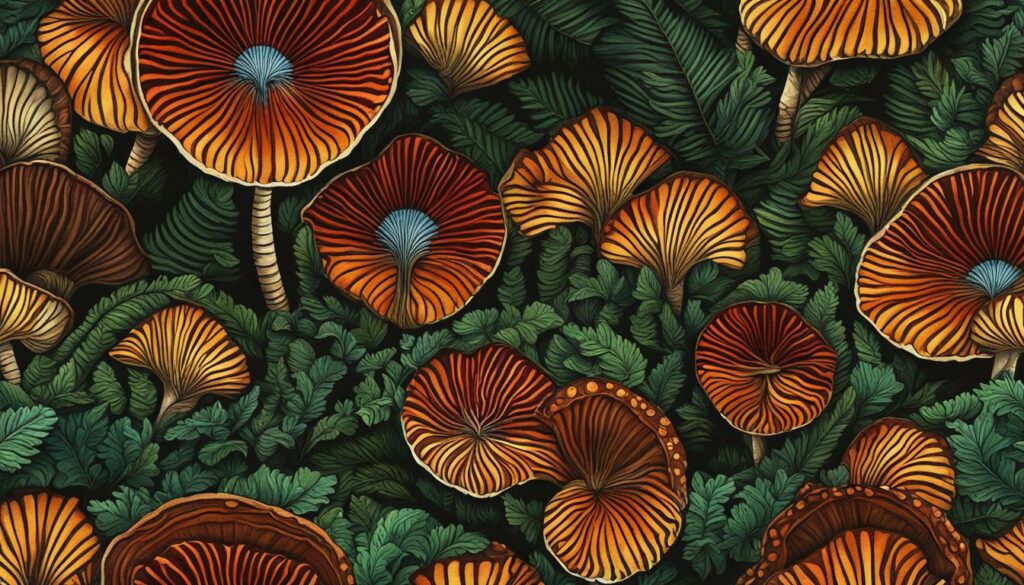
Polysaccharides, like the beta-glucans found in turkey tail mushrooms, are exceptional in this realm of natural ingredients. They are showing promise in promoting not only skin hydration but also supporting the formation and maintenance of collagen, which is vital for skin elasticity and structure.
The Role of Polysaccharides in Skin Care
As a beauty and wellness advocate, I’ve seen firsthand the transformative power of incorporating polysaccharides in skincare. Their ability to enhance the skin’s natural barrier function and support collagen synthesis paves the way for significant improvements in skin texture and tone. I have seen noticeable improvements in skin resilience, with a marked reduction in the appearance of fine lines and wrinkles.
Utilizing the skin-firming properties of turkey tail mushroom has been a game-changer for not only myself but for countless individuals seeking a more natural approach to achieving firmer skin.
Below is a detailed table that delineates the relationship between the polysaccharides found in turkey tail mushrooms and the health benefits they offer for our skin:
| Polysaccharide | Role in Skin Care |
|---|---|
| Beta-Glucans | Supports collagen production, improving skin firmness and refining texture |
| Polysaccharopeptides (PSP) | Stimulates skin renewal and may ease inflammation, enhancing skin appearance |
| Polysaccharide-K (PSK) | Aids in maintaining skin elasticity and defending against external stressors |
The impact of these compounds goes beyond mere aesthetics. Their presence in the turkey tail mushroom fosters an environment where skin cells can thrive, maintain an optimal balance of moisture, and respond to the aging process resiliently.
- Integration of turkey tail mushroom extracts can be pivotal for skin elasticity enhancement
- Discovering new regimes that leverage the structural benefits of polysaccharides for firmer skin
- Realizing the potential of natural ingredients like turkey tail mushroom to transform skincare
The incorporation of turkey tail mushroom for skin firmness into our skincare routines empowers us with the means to support our skin’s natural ability to stay elastic and firm. This, in turn, provides a foundation for a more vibrant, youthful appearance. As this ingredient continues to be studied, its place in the skincare world seems destined to grow, offering a potent, natural option for those aiming to maintain supple, resilient skin.
Addressing Skin Aging with Turkey Tail Mushroom
In the realm of anti-aging skincare, there emerges a natural protagonist known for its grace and effectiveness—the turkey tail mushroom. With my deepening interest in holistic skincare strategies, I have been enthralled by the potential of turkey tail mushroom and skin aging. These mushrooms, brimming with bioactive compounds, might just be the natural elixir sought by many to bolster collagen support and to wage a gentle war against the telltale signs of aging skin.
Notably, my investigation into these fungi revealed that the components of the turkey tail mushroom could work collaboratively to provide a powerful defense against wrinkles and skin laxity, key concerns for anyone invested in the anti-aging skincare narrative. Here, I delve into the specifics of how turkey tail mushroom harbors the potential to preserve the fountain of youth within our skin.
| Component | Anti-Aging Benefit |
|---|---|
| Antioxidants | Neutralize free radicals to reduce the appearance of fine lines and wrinkles |
| Polysaccharides | Hydrate and provide potential support for collagen synthesis, maintaining skin elasticity |
| Beta-Glucans | Assist in skin recovery from environmental stressors and promote firmness |
| Vitamins | Supports skin cell regeneration and aid in repairing UV damage |
With a focus on the collagen support the mushroom provides, it is imperative to highlight how these compounds may work in synergy to reinforce skin’s structure and stave off the sagging and wrinkling attributable to age. Beta-glucans, for example, have been known to play a significant role in hydration and skin recovery, potentially impacting skin firmness.
I’ve witnessed, through consistent application in my skincare regime, how turkey tail mushroom extracts have provided a noticeable uplift in my skin’s resilience, directly reflecting on its capacity to combat visible signs of aging.
- Enhanced skin firmness and elasticity
- Reduced appearance of fine lines and wrinkles
- Support for the skin’s protective barrier against environmental damage
The promising interplay of turkey tail mushroom’s natural artillery aligns with the principles of anti-aging skincare, directing towards a strategy that ensures our skin remains as timeless as the earth’s ancient forests from which these mushrooms spring. The continuing advancements in understanding the role of turkey tail mushroom and skin aging could potentially elevate the status of this humble fungus to that of a skincare staple for those who seek ageless beauty organically.
Hydrating Effects: Turkey Tail Mushroom and Skin Hydration
In my continual pursuit of uncovering hydrating skincare ingredients, I’ve been compelled by the skin moisturizing benefits of the turkey tail mushroom. The relationship between the turkey tail mushroom and skin hydration is a fascinating exploration into how natural elements can support our skin’s health. Did you know that hydration is the cornerstone of a plump and smooth complexion?
Understanding Skin’s Need for Hydration
Our skin is constantly exposed to factors that can strip it of moisture, leading to dryness and the appearance of fine lines. This underscores the importance of integrating elements into our skincare regimen which not only replenish this lost moisture but also inhibit its evaporation. In my skin hydration exploration, turkey tail mushrooms emerge as a valuable ally. Their natural makeup is innately geared towards bolstering our skin’s hydration levels.
Mushrooms’ Moisture-Retention Mechanisms
Fortunately, nature has equipped turkey tail mushrooms with potent moisture-retention mechanisms that can significantly benefit our skin. Specifically, the polysaccharides present are celebrated for their hygroscopic abilities. This means they can attract atmospheric moisture and lock it into the skin, thus sustaining its hydration.
When I explored the intricacies of these hydrating compounds, the potent polysaccharides found within these mushrooms stood out. Their ability to not only absorb but retain water showcases their promise as a potent hydrating skincare ingredient. The consequent impact on skin hydration is twofold: improved moisture levels and a supple, more youthful appearance.
Integrating turkey tail mushroom into my skincare routine proved to be transformative, enhancing my skin’s ability to stay hydrated and resilient against the daily environmental stressors.
For clarity, let’s delve into how the turkey tail mushroom compounds contribute to moisture retention:
| Hydrating Compound | Moisture-Retention Benefit |
|---|---|
| Polysaccharides | Attract and seal in moisture, aiding in the maintenance of the skin’s hydration levels |
| Beta-glucans | Form a “film” on the skin’s surface which can prevent transepidermal water loss |
- Polysaccharides in turkey tail mushrooms display a natural propensity to hydrate and protect the skin.
- The science behind these compounds enlightens us on their distinct ability to bolster our skin’s own hydrating functions.
- Regular use of skincare products containing turkey tail extracts can lead to visibly plumper and smoother skin.
As these mushrooms continue to captivate my interest with their skin hydrating potential, the notion of utilizing the turkey tail mushroom to improve skin moisturization becomes an increasingly persuasive argument. It is a natural, promising ingredient that could significantly alter the hydration conversation within the skincare community.
Turkey Tail Mushroom and Skin Nourishment: Topical vs. Ingested Benefits
As a passionate proponent of natural skincare, I’ve been captivated by the diverse applications of turkey tail mushroom and skin nourishment. It’s intriguing to learn that the benefits of this natural remedy can be experienced through two distinct methods: topical application and ingestion. Each offers unique advantages for maintaining and improving skin health.
Initially, I turned to the topical benefits of turkey tail mushroom, incorporating extracts into creams and serums. What I noticed was a notable improvement in my skin’s hydration and elasticity. It seemed that applying these mushroom-infused products directly to my skin allowed the active ingredients to work their magic right where it was needed.
Topically, turkey tail mushroom extracts are like food for the skin; they appear to instantly quench its thirst and aid in reinforcing its barrier.
However, I didn’t stop there. Intrigued by the prospect of ingested skincare benefits, I incorporated turkey tail mushroom supplements into my diet. While the topical approach provides direct nourishment to the skin, I found that ingestion may offer a deeper, more systemic support. By enhancing the immune defense and reducing inflammation from within, turkey tail mushroom seems to indirectly yet effectively support overall skin health.
| Intake Method | Primary Benefits for Skin Nourishment |
|---|---|
| Topical Application | Direct hydration and elasticity, targeted treatment |
| Ingestion | Internal immune support, anti-inflammatory effects |
The real beauty lies in the synergistic effect. Whether applied topically or ingested, the turkey tail mushroom provides a range of compounds such as antioxidants, polysaccharides, and beta-glucans, which are vital for maintaining a radiant and healthy skin.
- The antioxidants tackle the oxidative stress that can accelerate aging.
- The polysaccharides, when ingested, may strengthen the body’s defenses, which is critical for skin that resists inflammation.
- The beta-glucans keep the skin well-hydrated and may enhance its natural self-repair mechanism, both when ingested and applied topically.
My personal regimen now includes both, applying a turkey tail mushroom-enriched cream to my face and neck every morning and evening, as well as taking an oral supplement with meals. This approach ensures a comprehensive strategy that tackles skin health from multiple angles—enhancing, protecting, and repairing.
Ultimately, combining both topical and ingested forms of turkey tail mushroom seems to unlock its full potential for skin nourishment, resulting in a more holistic skincare approach. As someone devoted to uncovering the depths of natural skin remedies, embracing both topical and ingestible turkey tail mushroom has been both a breakthrough and a blessing for my skin’s health.
Conclusion: Embracing Turkey Tail Mushroom for Skin Vitality
In my comprehensive journey exploring the turkey tail mushroom benefits for skin, I’ve been guided by a blend of historical reverence and cutting-edge science. It’s this synergy that beautifully encapsulates why the turkey tail mushroom is more than just a mere addition to my skincare regimen—it’s a natural ally. With an impressive repertoire of antioxidants, polysaccharides, and beta-glucans, this fungus offers a treasure trove of skincare insights, emphasizing a holistic paradigm shift in our approach to skin health and beauty.
Through diligent research and personal testing, my perception of natural skin remedies has been transformed. I’ve borne witness to the tangible impacts these bioactive compounds have on my skin—from elevated hydration to improved elasticity and fortitude against the signs of aging. As I continue to uncover more about the elucidated skincare insights provided by the turkey tail mushroom, I’m optimistic about its future role in promoting radiant, supple, and youthful skin.
Indeed, it’s an exciting era for those of us pursuing natural skin remedies that not only support the skin’s surface but also enrich its deepest layers. I believe that turkey tail mushrooms have carved out their place in the pantheon of skincare superfoods, offering a multi-dimensional approach to combat skin concerns. As we move forward, the rich legacy and potent efficacy of turkey tail mushrooms will likely solidify their stature as a cornerstone in the quest for natural, healthy, and effulgent skin.
FAQ
What are the skin benefits of turkey tail mushrooms?
Turkey tail mushrooms are known for their antioxidants, anti-inflammatory properties, and bioactive compounds like polysaccharopeptides (PSP) and polysaccharide-K (PSK). These elements may help in reducing signs of skin aging, improving skin elasticity, enhancing skin glow, and increasing hydration.
How does turkey tail mushroom support skin rejuvenation?
The antioxidants present in turkey tail mushrooms help neutralize free radicals, protecting the skin from oxidative stress and potentially slowing the aging process. This can lead to a more youthful appearance and a reduction in wrinkles and fine lines.
Can turkey tail mushroom improve skin’s natural glow?
The antioxidant effects of turkey tail mushrooms can enhance skin’s natural radiance and improve overall complexion by helping to protect the skin from damage and support skin cell rejuvenation.
What makes turkey tail mushroom stand out in skincare?
Turkey tail mushroom stands out due to its high levels of PSP and PSK, which are key for their potential skin health benefits. Its rich array of bioactive compounds makes it a unique and potent ingredient in skincare formulations.
How can turkey tail mushrooms promote skin elasticity and firmness?
The compounds in turkey tail mushrooms, including polysaccharides such as beta-glucans, are believed to enhance skin structure by supporting collagen production. This can lead to improved skin elasticity and firmness.
What is the role of turkey tail mushroom in anti-aging skincare?
In anti-aging skincare, turkey tail mushrooms may help by boosting collagen production and protecting against UV-induced damage, thereby addressing common concerns such as the loss of skin firmness and the appearance of wrinkles.
How do turkey tail mushrooms aid in skin hydration?
Turkey tail mushrooms contain hygroscopic polysaccharides which can absorb and retain water. This helps improve the skin’s moisture content, leading to better hydration and a more supple skin appearance.
Is there a difference between topical and ingested turkey tail mushroom benefits for skin?
Yes, there is a difference. Topical application of turkey tail mushroom may deliver direct benefits like enhanced hydration and elasticity, while ingestion can support skin health from within by strengthening the immune system and reducing inflammation, which can have a positive effect on skin health.

